 |
|

|
 |
TABLE of CONTENTS
 |
Commissioner Zelle named new chairman of MAASTO |
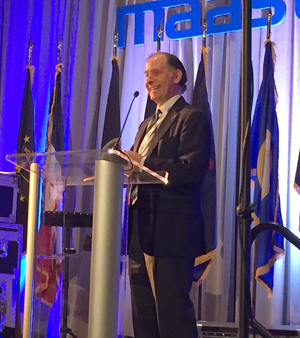
Commissioner Charlie Zelle spoke during the Mid-America Association of State Transportation Officials convention Aug. 10-13 in Overland Park, Kan. Zelle took over as the new chairman of MAASTO during the convention. Photo by Kevin Gutknecht |
Commissioner Charlie Zelle took over as the new chairman of the Mid-America Association of State Transportation Officials during MAASTO’s annual convention Aug. 10-13 in Overland Park, Kan.
“It's a great honor to be able to lead this important organization,” Zelle said. “I look forward to the coming year and working with member states to improve and promote transportation and transportation service across the Midwest.”
Zelle, who has been the vice-chair of MAASTO for the past year, has led MnDOT since 2013.
MAASTO's goal is to foster the development, operation and maintenance of an integrated and balanced transportation system that serves the transportation needs of the 10 member states—Illinois, Indiana, Iowa, Kansas, Kentucky, Michigan, Minnesota, Missouri, Ohio and Wisconsin.
MAASTO is a regional subset of the American Association of State Highway and Transportation Officials. AASHTO supports its members in the development of transportation solutions that create economic prosperity, enhance quality of life, and improve transportation safety in communities, states, and the nation as a whole. For more information, see www.transportation.org/.
MnDOT will host the annual MAASTO convention Aug. 8-11, 2016.
|
 |
|

|
 |
TABLE of CONTENTS
 |
2015 state bicycle map is now available |
By Sue Roe
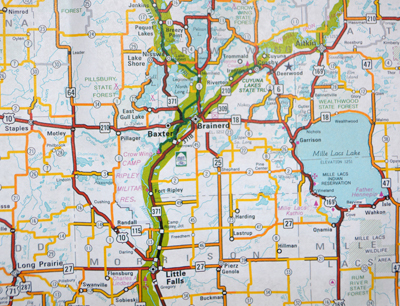
The new state bicycle map will be available at the State Fair. The map includes shoulder widths, pavement type and state and regional trails, including the Mississippi River Trail (shown in green). |
The new state bicycle map will be unveiled at the Minnesota State Fair (Aug. 27 to Sept. 7) at the Kick Gas exhibit inside the Eco Experience Building, according to Jasna Hadzic, planner in the Office of Transit’s bicycle and pedestrian section.
The map also will be available at the MnDOT booth in the Education Building.
Changes to the map include:
- Updates to the state bike trails
- Updates on locations of new paved shoulders along roads
- A new way traffic volume is displayed. The old map used the terms “light” or “heavy” when describing traffic volume, but the new map shows the volume according to categories, which includes cars per minute.
- Road shoulders were previously shown as four or more feet wide or zero to three feet wide. New shoulder data is displayed as bikeable shoulders, meaning the shoulder is four or more feet wide and paved.
The free map also shows road conditions and existing paved, bikeable shoulders and gravel roadways, all factors that make planning long-distance bicycle trips easier.
The map also includes shoulder widths, pavement type, state and regional trails, including the Mississippi River Trail, state historic sites, parks and points of interest, and safety tips. Minnesota Bicycle Friendly Communities, as designated by the League of American Bicyclists, are also highlighted.
“We will continue to improve the map,” Hadzic said. “We want to have inset maps of cities that will help bicyclists navigate through urban areas.”
Bicyclists, especially those making shorter trips, can also use the editable Cyclopath route planner at www.cyclopath.org.
To request a print version of the map, email bicyclemap.dot@state.mn.us. |
 |
|

|
 |
TABLE of CONTENTS
 |
State Fair offers many opportunities to engage visitors about transportation |
|
By Mary McFarland Brooks

Paul Woodward, transportation generalist, walks with a MnDOT snowplow during a parade at the 2014 Minnesota State Fair. Photo by David Gonzalez |
The annual 12 days of fun, Aug. 27 through Labor Day, is almost here again.
Bus ads for the 2015 Great Minnesota Get Together announce that if you are a Minnesotan, it’s mandatory to attend the State Fair. Stopping by the MnDOT booth to get a Minnesota highway map is mandatory for many people and a new version of the map is ready and waiting to be distributed.
Located in the Education Building at 1372 Cosgrove Street, MnDOT’s booth this year is focused on “Your Transportation System: Get Connected.” The display highlights:
- Community: How transportation touches almost everyone, every day
- Economy: How transportation helps businesses and the economy grow
- Innovation: How the St. Croix Crossing project is being built and is using an innovative bridge design to minimize impact to the environment
- Unmet needs of the transportation system: How creating a transportation system that works results in a better quality of life for all of Minnesota
MnDOT staff will provide information about road projects and show how transportation connects Minnesota residents with their community, region and world. They will engage visitors with a quiz on how transportation affects all Minnesotans. Fairgoers also will have the opportunity to see and touch examples of aging roadway materials up close.

The State Fair booth will highlight how transportation touches almost everyone, every day. Click on the image to see a larger version. Graphic created by Adam Oie |
Also included in the booth this year is an outreach effort by the Office of Transportation System Management that will include a trivia wheel, poster activities and the introduction of buttons championing the various transportation modes from barges to bicycles to engage visitors. Fairgoers will be asked to weigh in on the new Multimodal Transportation Plan and the State Highway Investment Plan www.mndot.gov/planning/smtp-mnship/. Planners will be interacting with visitors about transportation topics that are important to them.
“The state fair helps MnDOT connect with the people from all over the state who can provide immediate feedback on their transportation experiences,” said Commissioner Charlie Zelle. “This is an opportunity for us to learn what is essential and valuable to the people we serve.”
Visit the Kick Gas exhibit at the Eco Experience Building, where more MnDOT staff will be handing out state bicycle maps and encouraging people to bike or walk to some of their destinations.
For those who love a parade, check out Metro District crews as they drive a snowplow in the State Fair’s daily 2 p.m. parade on Thursday, Aug. 27, and Wednesday, Sept. 2.
More information can be found at the MnDOT State Fair website. |
 |
|

|
 |
TABLE of CONTENTS
 |
Employees invited to view St. Croix Crossing bridge construction up close |
By Kristin Calliguri
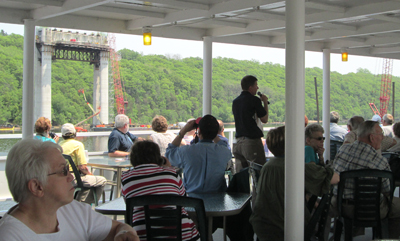
The St. Croix Crossing project team is narrating 16 public paddleboat tours hosted by the St. Croix Boat & Packet company throughout the 2015 construction season. Photo by Kristin Calliguri |
MnDOT employees, WisDOT employees and their families are invited to visit the St. Croix Crossing bridge construction site near Stillwater on paddleboat tours offered Aug. 26 and Sept. 14 after work.
“We had such a great response from our employees who attended the boat tours last year, we decided to offer the opportunity again this year,” said Michael Beer, St. Croix Crossing project director.
Tour times are from 5-6:30 p.m.
Employees who attend are doing so on their personal time and using personal funds for their boat ticket and mileage to Stillwater.
Cost for a boat ticket is $10 for adults, $6 for children age 4-12 and free for children age 0-3.
Tickets can be purchased by calling St. Croix Boat & Packet at 651-430-1234. When you call, tell them you want tickets for the MnDOT Employee tour. MnDOT also has been giving public tours and those are all sold out.
The paddleboat leaves from St. Croix Boat & Packet at 5 p.m. Attendees should plan to arrive a few minutes early. The boat dock address is 525 S. Main St., Stillwater.
Free parking is available adjacent to the boarding area. Follow the ‘Boat Parking’ sign.
|
This time lapse video shows the construction of St. Croix Crossing bridge piers.Video produced by EarthCam |
|
 |
|

|
 |
TABLE of CONTENTS
 |
Cleanup on I-94: How MnDOT handles semitrailer rollovers |
|
By Bob Filipczak
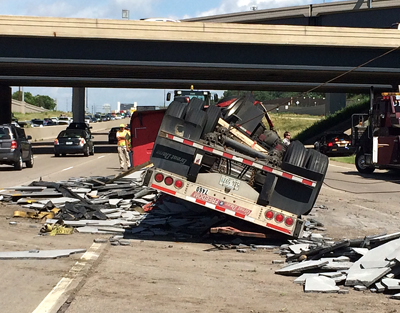
Truck carrying granite last year rolled over on the ramp from Hwy 169 to I-494 in Eden Prairie, with granite blocking all lanes of traffic. Photo by Doug Thies |
It takes a lot to close a highway in Minnesota. When it’s not a huge storm causing the closing, one can count on it being a rolled-over 18-wheeler, blocking lanes and sometimes spilling its contents.
There’s no good time for this to happen, but when it happens in the Twin Cities metro area right before rush hour, it complicates matters.
Doug Thies is a Metro District safety administrator who has become very knowledgeable on semitrailer rollover incidents. When there is a rollover in the Twin Cities, dispatch notifies someone in his office. How the incident is handled is determined by the complexities involved. Leaking fuel, hazmat and unique issues with up-righting the semi trailer are some of the factors that go into how the district sets its game plan in motion to make sure the highway is reopened as quickly as possible.
The FIRST trucks are usually first on the scene with the State Patrol. Sometimes, if they are getting images of the crash from the Regional Transportation Management Center in Roseville, they can tell how bad it is and what resources they will need when they get there.
When on the scene, the priorities are:
- Safety—of MnDOT employees, public safety staff and the public
- Environmental concerns and cleanup
- Opening the highway and restorating damaged infrastructure
The key to determining the safety of everyone involved is the answer to the question: What is in the truck? MnDOT has encountered everything from animals to animal feed to toxic materials.
“It gets more complicated every week,” said Thies. “There are so many different types of freight moving on our freeways that you never know what you might encounter. You have to understand MnDOT procedures, emergency response agencies’ procedures, hazardous materials procedures, tow company procedures, and you have to be comfortable and confident.”
Thies said one of the worst spills occurred a few years ago when a tanker spilled sodium hydroxide, which is a strong alkaline chemical. Even when the contents of the truck aren’t dangerous, most trucks have a tank that contains between 75 and 300 gallons of diesel fuel that may have spilled.
“Liquids you wouldn’t suspect of causing trouble can be bad for the environment,” said Kohl Skalin, District 4 safety administrator. “We had a milk truck that hit a bridge pier at an underpass a few years back, and when a lot of milk spills in a concentrated area, it can damage the water quality and affect local streams and lakes. If you have a large volume of anything pouring out of a truck, it can damage the surrounding environment and needs to be cleaned up.”
|
“As ironic as it might seem, most people think 'Well this trucker must not be familiar with the area.' Believe it or not, the majority of the truck drivers that tip over their trucks—that’s their normal daily route.” —Doug Thies, Metro District safety administrator
|
Skalin said his worst spill so far was a tanker full of miracid, which is a great fertilizer until tons of it spill in one area.
Skalin’s job is to evaluate the spill, contain it if he can, and then hire a contractor to clean it up.
“In greater Minnesota, MnDOT primarily gets called in for traffic control,” said Al Milbradt, District 4 maintenance supervisor. “In the case of the milk truck crash, it was easy to route everyone up the exit ramps and around the bridge.”
Milbradt noticed there were still significant traffic backups because everyone was stopping at the stop signs at the end of the ramps. He went out with flags and directed traffic to keep everything moving.
One of the most important tools Thies carries to every crash scene is the Instant Response Report form. It’s a checklist of all the information they need to get once they are on the scene, including names, phone numbers, yellow tag information, responsible parties and insurance company.
“By getting all of this information at the scene, it helps us assess the situation and eventually collect the funds to pay for cleaning up the crash,” said Thies. “This way we are making sure it gets cleaned up and the road gets opened safety, but also making sure we don’t get stuck with the bill.”
Getting stuck with the bill is rare now, but that wasn’t always the case before the Instant Response Report form.
“What’s made us successful is we’ve done a good job in the metro area marketing the idea that we really need to know this information,” said Thies. “The State Patrol does a good job of bringing us in the loop right away.”
Thies’ relationship with the State Patrol has been particularly important. With his degree in emergency management, his 19 years as a firefighter and his 12 years at MnDOT, Thies has a reputation as an expert. In fact, once a year, he is invited to speak to State Patrol cadets about some of the things they might encounter out on the road and in the ditches when the trucks start rolling over. |
 |
|

|
|

|
 |
TABLE of CONTENTS
 |
Americans with Disabilities Act marks 25th anniversary – Have we done all we can? |
By Todd Grugel, ADA Program engineer
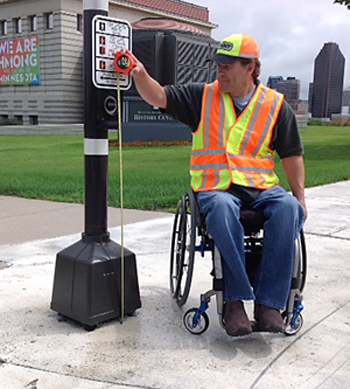
Todd Grugel, ADA Program engineer, measures the height of a pedestrian push button at a crosswalk. Photo by Harvey Unruh |
A common sentiment I hear from individuals with disabilities is “I want to do it myself.” Physical disabilities and barriers can take away a person’s independence and reduce their quality of life.
Restoring that independence and making a difference in people’s lives is a very rewarding part of my job as MnDOT’s ADA Program engineer, along with the significant challenges of the work itself. I’ve heard numerous stories that we should be proud of as a department - about how we’ve better allowed people to get out of their homes and be more engaged in their communities because of the accessible improvements we’ve completed in their towns all across the state.
Looking back over the last five years of designing and constructing accessible pedestrian facilities, I believe we’ve made great strides in curb ramp and accessible pedestrian signal construction. It is very gratifying to see we are starting to tackle sidewalk and driveway construction in order to provide a barrier-free sidewalk system.
The Americans with Disabilities Act is a landmark federal disability rights legislation enacted in 1990 marking its 25th anniversary this month. There was a time in my life when I never used to think that much about curb ramps, sidewalks or ADA in general. However, life can change very quickly and unexpectedly as I learned Oct. 26, 1998. That day was an ordinary Monday morning when I was working on site on the new Hwy 212 project in Eden Prairie, inspecting a bridge that I helped design the previous winter. I don’t remember much of that morning, but as I was measuring pile cut-offs, I was struck by a 25-foot, 850-pound tube pile that fell like a tree on my upper back and left me paralyzed from the waist down.
As one might imagine after such a life-changing event, nothing is the same—from routine activities like getting out of bed in the morning and getting dressed, to dealing with ongoing pain and medical issues, to encountering barriers in daily living. The Americans with Disabilities Act was created to eliminate many of those physical barriers so persons with disabilities can enjoy the same activities that most people take for granted. For example, if there’s either no sidewalk or a snow-covered sidewalk, able-bodied individuals can simply walk on the grass boulevard or through the snow. However, wheel chairs are confined to the roadway. And, most users can freely and easily step into a building where wheel chairs are unable to enter.
I think almost everyone agrees with the basic principle of the ADA legislation, which is providing equal access for everyone. But when it comes to applying the specifics of a single requirement on an individual roadway project, such as providing a minimum clear width distance for a wheel chair to pass around a light pole in the middle of the sidewalk, people often question if it’s worth the time, cost or effort to provide that access. The need is often questioned by asking “Who is going to use this sidewalk anyway? I don’t see anyone in a wheel chair,” or “I’d like to fix this but it’s beyond the scope of the project.”
That type of situation takes on a whole new meaning or priority when someone close to you is directly impacted by a disability and they must daily deal with the numerous barriers and difficulties that often don’t cross the mind of the general public. When you or someone you are with can’t get around that light pole and they need to go back to the nearest driveway or curb ramp in order to travel in the street instead of the impassable sidewalk, it becomes a much more real issue.
Raising awareness and understanding is key to solving this type of situation so project personnel know how important these issues are to people with disabilities. And really, it goes much further than project personnel. There are many things all of us as transportation professionals can do to knock down barriers and provide access, including prioritizing and allocating funding, shaping policies and practices, providing accessible communication, collaborating with local partners, training and education, and providing reasonable accommodations for employment, just to name a few.
We all have a role to play in this since most things we do as a public agency have some effect on individuals with a disability. The good thing about that is we all have the opportunity to choose to make a positive impact on people’s lives that really make a difference.
|
 |
|
| |
|



